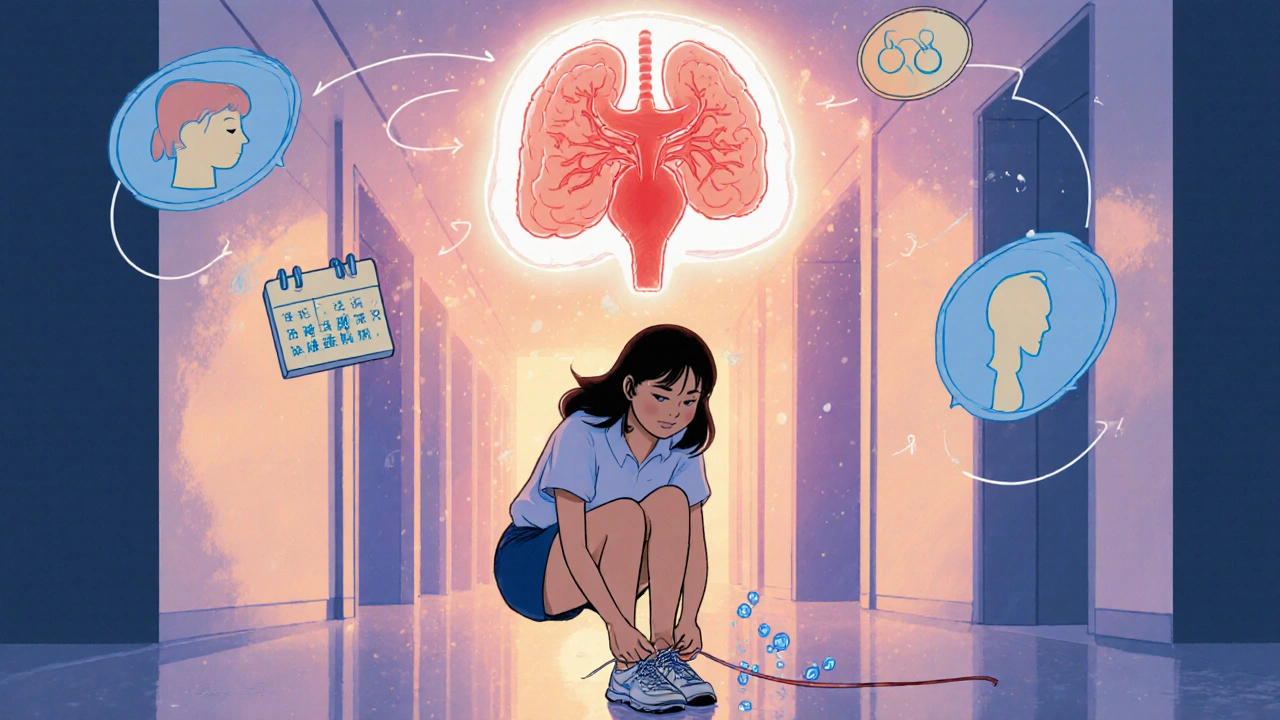Hyperprolactinaemia Exercise Planner
Create a personalized weekly exercise plan based on the latest research. Select your preferred exercise types and availability to generate a safe, effective routine that supports hormonal balance.
Select your options and click "Generate Personalized Plan" to see your customized routine.
Important: Follow the guidelines from the article: don't overtrain (max 5 days/week), prioritize sleep, and track your symptoms. Always consult your healthcare provider before starting a new exercise program.
Living with hyperprolactinaemia is a daily juggling act. The condition pushes prolactin-a hormone made by the pituitary gland-well above normal, leading to headaches, menstrual changes, low libido, and even bone‑density loss. While medication is the first line of treatment, research over the past decade shows that regular physical activity can be a powerful ally in taming those excess hormone levels.
What Exactly Is Hyperprolactinaemia?
In simple terms, hyperprolactinaemia means "high prolactin in the blood." Prolactin’s main job is to kick‑start milk production after childbirth, but it also talks to other hormones that control the menstrual cycle, stress response, and metabolism. When something-like a pituitary tumor, certain medications, or chronic stress-causes prolactin to rise, the whole hormonal orchestra gets out of sync.
Why Exercise Matters for Hormonal Balance
Exercise isn’t just burning calories; it’s a stress‑relief tool that sends powerful signals to the brain and endocrine system. Here are three core ways movement fights hyperprolactinaemia:
- Dopamine boost: Aerobic workouts increase dopamine, a neurotransmitter that naturally suppresses prolactin secretion.
- Insulin sensitivity: Better insulin handling lowers overall inflammation, which can indirectly reduce prolactin spikes.
- Body composition: Losing excess fat, especially around the abdomen, lowers estrogen conversion that sometimes fuels prolactin production.
In short, exercise creates a cascade: muscle activity → dopamine rise → prolactin drop → symptom relief.
Best Types of Physical Activity for Lowering Prolactin
Not all workouts are created equal. Below is a quick‑reference table that matches exercise styles with the hormonal benefits most relevant to hyperprolactinaemia.
| Exercise Type | Primary Hormonal Benefit | Recommended Frequency |
|---|---|---|
| Aerobic (running, cycling, brisk walking) | Boosts dopamine → suppresses prolactin | 30‑45min, 3‑5times/week |
| Resistance Training (weights, bodyweight) | Improves muscle mass → lowers body fat → reduces estrogen‑driven prolactin | 2‑3sessions/week, 8‑12 reps |
| High‑Intensity Interval Training (HIIT) | Sharp dopamine spikes + insulin sensitivity | 15‑20min, 2‑3times/week |
| Mind‑Body (yoga, tai chi) | Reduces cortisol → less stress‑induced prolactin | 20‑30min, daily or as needed |
Pick at least two categories each week to hit both dopamine and body‑composition goals.

Designing a Weekly Routine: A Sample Plan
- Monday - Cardio Warm‑up: 30minutes of moderate‑pace jogging. Aim for a conversation‑friendly pace; this keeps cortisol low while raising dopamine.
- Tuesday - Full‑Body Strength: 3 sets of squats, deadlifts, and push‑ups (8‑12 reps each). Rest 60‑seconds between sets to keep heart rate elevated.
- Wednesday - Yoga Flow: 25minutes of gentle Vinyasa focusing on breath. Notice how breathwork calms the nervous system, indirectly helping prolactin settle.
- Thursday - HIIT Sprint: 8 rounds of 30‑second sprint + 90‑second walk. The short, intense bursts are proven to spike dopamine quickly.
- Friday - Light Cardio + Core: 20‑minute brisk walk followed by 10 minutes of planks and side‑planks.
- Saturday - Active Rest: Choose a fun activity-hiking, dancing, swimming. The key is moving without structured intensity.
- Sunday - Recovery: Stretch, foam roll, and aim for 8‑9hours of sleep. Sleep quality is another pillar that keeps prolactin in check.
Adjust the plan to suit your fitness level. Even swapping a 30‑minute walk for a 5‑minute meditation can make a difference if you’re struggling with time.
Real‑World Success Stories
Emily, a 32‑year‑old teacher, was diagnosed with hyperprolactinaemia after experiencing irregular periods and chronic headaches. Her endocrinologist prescribed a dopamine agonist, but Emily wanted to reduce medication. She started the routine above, adding a 10‑minute evening walk after dinner. Within three months, her prolactin labs dropped from 85ng/mL to 45ng/mL, and her menstrual cycle normalized. She reports less fatigue and a stronger mood.
Another case: Mark, a 45‑year‑old engineer on antipsychotic medication (a known prolactin‑raising drug), began a modest strength‑training program twice a week. After six months, his prolactin fell by 30% and his libido improved dramatically. Mark’s story underscores that exercise can offset medication‑induced prolactin spikes when done consistently.

Potential Pitfalls and How to Avoid Them
While the benefits are clear, a few common mistakes can blunt results:
- Overtraining: Pushing too hard raises cortisol, which can actually increase prolactin. Stick to the recommended frequency and listen to your body.
- Ignoring Nutrition: A diet high in refined carbs spikes insulin, which may aggravate hormonal imbalance. Prioritize protein, leafy greens, and omega‑3s.
- Skipping Sleep: Poor sleep disrupts the dopamine‑prolactin axis. Aim for consistent 7‑9hours.
- Not Tracking Progress: Without labs or symptom logs, it’s hard to see improvements. Keep a simple journal noting mood, menstrual changes, and any lab results.
Frequently Asked Questions
Can exercise completely replace medication for hyperprolactinaemia?
Exercise can significantly lower prolactin levels and relieve symptoms, but it rarely replaces medication for severe cases. Always discuss any changes with your endocrinologist.
How quickly can I expect to see hormone changes?
Most people notice mood and energy improvements within 4‑6weeks. Lab‑confirmed prolactin drops usually appear after 8‑12weeks of consistent training.
Is any type of cardio better than another?
Steady‑state cardio (like brisk walking or cycling) reliably raises dopamine. HIIT adds an extra insulin‑sensitivity boost, so mixing both yields the best hormonal profile.
Should I avoid any foods while focusing on hormonal balance?
Limit high‑sugar snacks and excessive caffeine, as they can raise cortisol and interfere with dopamine production. Opt for whole grains, lean protein, and plenty of vegetables.
Can stress management techniques complement exercise?
Absolutely. Mindfulness, deep‑breathing, and adequate sleep create a low‑cortisol environment, letting the dopamine‑prolactin pathway work more efficiently.
Bottom Line: Move to Balance
Hyperprolactinaemia may feel like a relentless hormonal roller coaster, but regular, well‑structured exercise can pull the lever back toward stability. By combining aerobic sessions, strength work, and mind‑body practices, you address the three biggest hormonal drivers-dopamine, insulin, and cortisol. Pair this with balanced nutrition, solid sleep, and routine lab checks, and you’ll likely see fewer headaches, steadier periods, and a revived sex drive.
Remember, every body responds differently. Start small, track your numbers, and keep the conversation open with your healthcare provider. Your next workout could be the key to dialing down prolactin and reclaiming everyday vitality.

Adding a little cardio to your week can really tip the dopamine scale in your favor. Aim for a steady‑state jog or bike ride where you can hold a conversation; that keeps cortisol low while still boosting dopamine. Pair it with two strength sessions and you’ll start seeing the fat‑loss that helps lower estrogen conversion. Keep the workouts consistent-3 to 5 times a week-and track how you feel day to day. Consistency beats intensity when you’re balancing hormones.